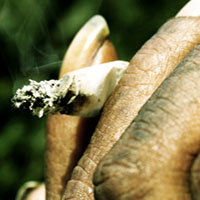UMN Researchers and Native American Tribe Hope to Reduce Lung Cancer Disparities
May 8, 2018

Despite decreases in lung cancer mortality rates among the general U.S. population, lung cancer remains one of the most prevalent malignancies among American Indians in Minnesota. To address this disparity, scientists from the University of Minnesota are teaming up with the Mille Lacs Band of Ojibwe in Onamia, Minn., to investigate aspects of lung cancer and nicotine metabolism from commercial tobacco use that may be unique to the American Indian populations in Minnesota.
As part of this collaboration, University researchers with the Minnesota Precision Medicine Collaborative (MPMC) will conduct two pilot studies.
Nicotine metabolism pilot study
One of the pilot studies, conducted by post-doctoral scientists Dana Carroll and Ellen Meier in the Masonic Cancer Center’s Tobacco Research Program, will focus on the rate of nicotine metabolism in current Mille Lacs Band of Ojibwe smokers.
Pharmacologic smoking cessation treatment has been tailored to nicotine metabolism in a few clinical trials among mostly white smokers. In one large trial, prescribing varenicline (e.g., Chantix) to individuals with normal-to-fast nicotine metabolism proved more effective than prescribing a nicotine patch on the skin. Among slow metabolizers, the efficacy of the two methods did not differ, but side effect severity was lower for the patch.
Treatment and early detection of lung cancer pilot study
University researchers will also investigate if disparities in lung cancer mortality rates may be a result of poor access to screenings. In the second pilot study, pulmonologist and assistant professor of medicine Abbie Begnaud will work closely with the Mille Lacs Band of Ojibwe medical staff to test a new approach to lung cancer treatment and early detection.
Begnaud, who directs the Lung Cancer Screening Program at the University of Minnesota, says the most important advancement in lung cancer treatment is the discovery of genetic mutations that drive lung cancer progression, along with therapies targeted at those mutations.
In a related retrospective study, Begnaud will also look at existing, de-identified data of American Indians treated for lung cancer at five Minnesota health systems to see if lung cancers that carried a special mutation were treated with precision medicine therapies or if they were tested for the mutation at all.
Establishing a partnership
The pilot studies will be conducted at clinics operated by the Mille Lacs Band of Ojibwe with the support of the tribe’s health commissioner, Rebecca St. Germaine.
“This is a welcome initiative that creates a partnership with American Indian tribal health initiatives to broaden our scope of clinical practices and change the future on disabling chronic conditions,” said St. Germaine.
Pamala Jacobson, one of the MPMC’s principal investigators, said it is necessary for researchers take the time to establish authentic, honorable working relationships within communities affected by health disparities.
“For precision medicine approaches to be effective, we have to know how to apply this exciting new science to all populations, not just healthcare systems in metropolitan areas or those serving high income patients,” said Jacobson. “Conducting the needed research and implementing precision medicine to benefit the health of American Indians and other minority populations is a priority.”
MPMC investigators and the Mille Lacs Band of Ojibwe have been planning their work together for nearly a year to ensure that the research is not only respectful of Ojibwe beliefs and practices but will be of value to the tribe.


